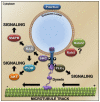Biogenesis and function of the NGF/TrkA signaling endosome
- PMID: 25619719
- PMCID: PMC4307610
- DOI: 10.1016/bs.ircmb.2014.10.002
Biogenesis and function of the NGF/TrkA signaling endosome
Abstract
Target-derived neurotrophin nerve growth factor (NGF) and its receptor TrkA are well known for retrograde signaling to promote survival and innervation of sympathetic and sensory neurons. In recent years, the signaling endosome model has been used to describe the sustained NGF/TrkA retrograde signaling as a process of endocytosis and retrograde transport of NGF/TrkA-containing endosomes from the axon terminal to the cell body for activation of NGF-inducible gene expression responsible for neuronal survival and development. Here, we review the biogenesis and function of NGF, TrkA, and the signaling endosome and discuss possible roles of Rab GTPases in the biogenesis and trafficking of signaling endosomes.
Keywords: Endocytosis; Membrane trafficking; NGF; Neurotrophin; Rab; Retrograde transport; Signaling endosome; TrkA.
Copyright © 2015 Elsevier Inc. All rights reserved.
Figures



References
-
- Abbott A. Neuroscience: one hundred years of Rita. Nature. 2009;458:564–567. - PubMed
Publication types
MeSH terms
Substances
Grants and funding
LinkOut - more resources
Full Text Sources
Other Literature Sources

